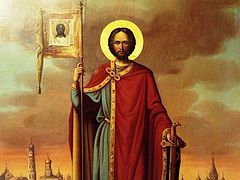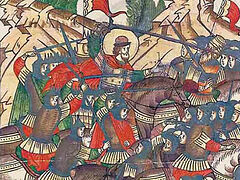St. Petersburg, December 7, 2023
On August 30, 1724, according to the order of Emperor Peter I, the relics of St. Alexander Nevsky, previously treasured in the city of Vladimir, were installed in the St. Alexander Nevsky Lavra in St. Petersburg.
This week, the Russian Orthodox Church kicked off the year-long celebration of the 300th anniversary of the transfer of the relics.
On Tuesday, December 5, on the eve of the feast of St. Alexander, His Grace Bishop Benjamin of Kronstadt, abbot of the St. Alexander Nevsky Lavra, served a moleben at the precious relics, housed in the monastery’s Holy Trinity Cathedral, reports the Russian Orthodox Church.
An exhibition, “Alexander Nevsky: Warrior and Saint,” was also opened.
Bp. Benjamin preached: “It’s impossible to imagine St. Petersburg without the blessed Grand Duke Alexander Nevsky. The entire history of the city on the Neva is connected with this saint. Emperor Peter I founded our city and our monastery, and thanks to the fact that he ordered the transfer of his relics, St. Petersburg found a Heavenly patron.”
His Grace noted that many events will be held throughout 2024, concluding with a religious procession on September 12.
Later that evening, His Eminence Metropolitan Barsanuphius of St. Petersburg and Bp. Benjamin celebrated the All-Night Vigil for the feast of St. Alexander and an akathist.
The next morning, Met. Barsanuphius, Bp. Benjamin, and His Grace Bishop Mstislav of Tikhvin celebrated the Divine Liturgy at the Lavra.
***
St. Alexander Nevsky (Alexei in monasticism) died on his way back from the Horde in Gorodets on November 14, 1263, and was buried on November 23/December 6 in the Nativity Monastery in Vladimir. His veneration began immediately after his burial, as it was marked by a miracle: The saint extended his hand for the prayer of absolution. The incorrupt relics were discovered before the Battle of Kulikovo, in 1380, and then a local celebration was established. The grand prince was glorified for general Church veneration during the reign of Metropolitan Makary, at the Moscow Council in 1547. On August 30, 1721, Emperor Peter I concluded the Treaty of Nystad after the war with the Swedes. This day was decided to be consecrated by transferring the relics of the saint to the new capital—St. Petersburg. Taken from Vladimir on August 11, 1723, the relics arrived in Shlisselburg on September 20, and on August 30, 1724, they were placed in the Alexander Nevsky Monastery.
Follow OrthoChristian on Twitter, Vkontakte, Telegram, WhatsApp, MeWe, and Gab!




